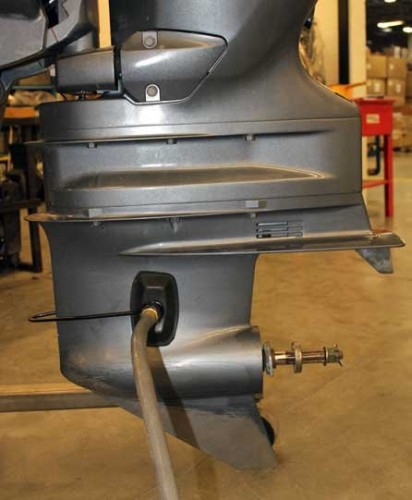Outboard Winterizing
October 17, 2013 It used to be as simple as “ear muffs” for running fresh water into an outboard, spraying some fogging agent into the carburetor air intake, clean and grease the prop shaft, change the zincs, change the lower unit gear lube and Presto, it’s done, let’s watch football ! Ok, with an older two cycle engine that may still suffice, but modern four cycle engines need a bit more love and attention (plan on recording that game on the DVR). Is Flushing Necessary ? For fresh water boaters, probably not. For saltwater engine use, ABSOLUTELY ! Saltwater is a silent, corrosive killer that can corrode aluminum and accelerate rust on steel. It also leaves behind salt deposits that can build up inside the cooling passages of your engine and cause blockages over time. Flushing also will remove residue debris, silt, sand and some marine growth. Still want to use “Ear Muffs” on your newer engine ? See if there are only two water intakes on your engine. Some newer engines have additional openings which will need to be blocked off, or taped shut. Some engines have only forward facing intakes and muffs won’t work at all or screens will need to be removed. Run the engine for about 10 minutes or until it’s up to temperature. Keep the RPM’s low (around 1000 RPM max) and keep the engine in neutral. Make sure the engine is “peeing” from the tell tale outlet on the rear housing, just as it does in the water.
Most newer engines employ some sort of built in flushing adapter that can make the job easier. Note that some engines flush while off and should not be run while using the flushing adapter. This is where you should pull out your engine manual and really study what it specifically needs. Watch the draining and storage requirements of your specific engine and determine if you need to use antifreeze.
Flushing is the easy part of winterizing an outboard. Unless you are comfortable with tools, following instructions, fogging sprays, fuel additives, following instructions, changing lower unit lube, changing crankcase lube (did I say following instructions ??) you might consider having the yard winterize the engine !
OK, now the disclaimer… every manufacture has slightly different steps, parts, suggestions and caveats regarding winterizing their engines. (some instructions even differ with various horsepower within a brand), SO READ YOUR MANUAL before you even think of starting or buying supplies. The steps and suggestions expressed here are general in nature and are NOT to be construed as complete for every manufacturer’s engines.
Assuming you have treated your fuel with additive to stabilize it from ethanol blended fuels breaking down and absorbing water, and have either emptied your tank (now recommended) or filled your tank to 80 % with new, treated fuel, you can begin. Note that some extra space should be maintained in the tank to allow for expansion and contraction of the fuel with temperature changes. A partially full tank is not recommended because the void space above the fuel allows air movement that can bring in water through condensation as the air temperature moves up and down. This condensation could potentially become a problem.
Run the treated fuel through the engine as you are flushing and then disconnect the fuel hose until it stops. It is important to follow a step by step process to make sure that all fuel is drained from the carburetor or injection system to prevent build-up of deposits from evaporated fuel. Use fogging oil in the cylinders to lubricate the cylinder walls and pistons. Beware of over cranking the engine without water running through it. Spray the engine block, wiring and components with either the manufacturer’s recommended moisture displacing / protective / lubricating spray or a commercially available spray like CRC or WD40. Note that professional outboard shops make up a fogging “juice” of fuel, stabilizer, fogging oil and secret ingredients and run it through the engine from a separate “fogging tank”. This insures that all internal fuel passages, as well as the cylinders are coated and stabilized for the winter. Seriously consider this approach.
The lower gearcase lube should be changed and the prop should be removed, the shaft lubricated and re-installed. Consider sending out the prop for re-conditioning if you have nicked it. A four cycle engine will also need the crankcase lube oil changed (like changing the oil on a car) and the filter changed.
If the motor is equipped with power tilt and trim, check the fluid level in the pump and top off if necessary. Refer to your owner’s manual for specific instructions on how to check the pump fluid level. Apply a film of grease to the tilt/trim rams to prevent corrosion and pitting.
Clean and wax the outside cowling of the engine, replace the zincs as required and touch up scratched or scraped spots that are showing bare aluminum on the engine. Look in your manual for lubrication points and use the appropriate grease or grease gun to lube.
Finally, store motor in the "down" position. This will ensure all water is completely drained, and prevents water from collecting in the exhaust and prop area. Also, with the motor in the lowest position, the tilt/trim rams (if equipped) are retracted within the pump housing, preventing surface corrosion on metal that would otherwise be exposed. Finally, disconnect the battery.
Now you should be ready for the spring, and that football game !
By Captain Rick Delfosse 203-216-7800 rick@rdelfosse.com
Rick is a Coast Guard captain, National Safe Boating Council close-quarters boat-handling and open water boat handling instructor, Connecticut and New York certified safe boating instructor and a US Sailing-certified instructor. He also conducts on-the-water courses and classroom seminars on coastal cruising and boating skills. The owner of a 43-foot pilothouse cutter and an Aquasport powerboat, he has extensive cruising and one-design, coastal and offshore racing experience.
.
Still want to use “Ear Muffs” on your newer engine ? See if there are only two water intakes on your engine. Some newer engines have additional openings which will need to be blocked off, or taped shut. Some engines have only forward facing intakes and muffs won’t work at all or screens will need to be removed. Run the engine for about 10 minutes or until it’s up to temperature. Keep the RPM’s low (around 1000 RPM max) and keep the engine in neutral. Make sure the engine is “peeing” from the tell tale outlet on the rear housing, just as it does in the water.
Most newer engines employ some sort of built in flushing adapter that can make the job easier. Note that some engines flush while off and should not be run while using the flushing adapter. This is where you should pull out your engine manual and really study what it specifically needs. Watch the draining and storage requirements of your specific engine and determine if you need to use antifreeze.
Flushing is the easy part of winterizing an outboard. Unless you are comfortable with tools, following instructions, fogging sprays, fuel additives, following instructions, changing lower unit lube, changing crankcase lube (did I say following instructions ??) you might consider having the yard winterize the engine !
OK, now the disclaimer… every manufacture has slightly different steps, parts, suggestions and caveats regarding winterizing their engines. (some instructions even differ with various horsepower within a brand), SO READ YOUR MANUAL before you even think of starting or buying supplies. The steps and suggestions expressed here are general in nature and are NOT to be construed as complete for every manufacturer’s engines.
Assuming you have treated your fuel with additive to stabilize it from ethanol blended fuels breaking down and absorbing water, and have either emptied your tank (now recommended) or filled your tank to 80 % with new, treated fuel, you can begin. Note that some extra space should be maintained in the tank to allow for expansion and contraction of the fuel with temperature changes. A partially full tank is not recommended because the void space above the fuel allows air movement that can bring in water through condensation as the air temperature moves up and down. This condensation could potentially become a problem.
Run the treated fuel through the engine as you are flushing and then disconnect the fuel hose until it stops. It is important to follow a step by step process to make sure that all fuel is drained from the carburetor or injection system to prevent build-up of deposits from evaporated fuel. Use fogging oil in the cylinders to lubricate the cylinder walls and pistons. Beware of over cranking the engine without water running through it. Spray the engine block, wiring and components with either the manufacturer’s recommended moisture displacing / protective / lubricating spray or a commercially available spray like CRC or WD40. Note that professional outboard shops make up a fogging “juice” of fuel, stabilizer, fogging oil and secret ingredients and run it through the engine from a separate “fogging tank”. This insures that all internal fuel passages, as well as the cylinders are coated and stabilized for the winter. Seriously consider this approach.
The lower gearcase lube should be changed and the prop should be removed, the shaft lubricated and re-installed. Consider sending out the prop for re-conditioning if you have nicked it. A four cycle engine will also need the crankcase lube oil changed (like changing the oil on a car) and the filter changed.
If the motor is equipped with power tilt and trim, check the fluid level in the pump and top off if necessary. Refer to your owner’s manual for specific instructions on how to check the pump fluid level. Apply a film of grease to the tilt/trim rams to prevent corrosion and pitting.
Clean and wax the outside cowling of the engine, replace the zincs as required and touch up scratched or scraped spots that are showing bare aluminum on the engine. Look in your manual for lubrication points and use the appropriate grease or grease gun to lube.
Finally, store motor in the "down" position. This will ensure all water is completely drained, and prevents water from collecting in the exhaust and prop area. Also, with the motor in the lowest position, the tilt/trim rams (if equipped) are retracted within the pump housing, preventing surface corrosion on metal that would otherwise be exposed. Finally, disconnect the battery.
Now you should be ready for the spring, and that football game !
By Captain Rick Delfosse 203-216-7800 rick@rdelfosse.com
Rick is a Coast Guard captain, National Safe Boating Council close-quarters boat-handling and open water boat handling instructor, Connecticut and New York certified safe boating instructor and a US Sailing-certified instructor. He also conducts on-the-water courses and classroom seminars on coastal cruising and boating skills. The owner of a 43-foot pilothouse cutter and an Aquasport powerboat, he has extensive cruising and one-design, coastal and offshore racing experience.
.
Categories: None
